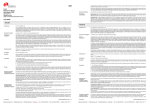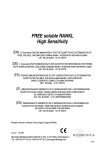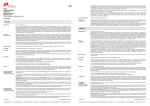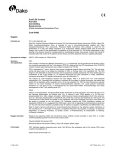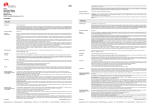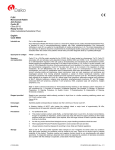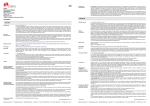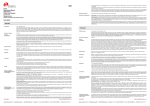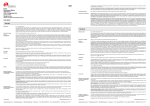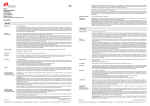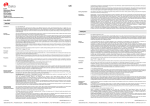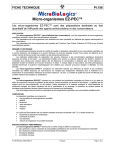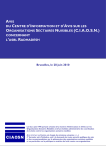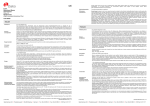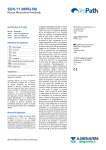Download FLEX Monoclonal Mouse Anti-Human MUM1 Protein Clone
Transcript
Positive and negative controls should be run simultaneously using the same protocol as the patient specimens. The positive control tissue should include colon/appendix and tonsil and the cells/structures should display reaction patterns as described for this tissue in “Performance characteristics” in all positive specimens. The recommended negative control reagent is FLEX Negative Control, Mouse, (Dako Autostainer/Autostainer Plus) (Code IS750). FLEX Monoclonal Mouse Anti-Human MUM1 Protein Clone MUM1p Ready-to-Use (Dako Autostainer/Autostainer Plus) Staining interpretation Cells labeled by the antibody display predominantly nuclear staining, although weak to moderate staining of the cytoplasm is also present in most cases with nuclear positivity (2). Performance characteristics Normal tissues: In tonsil and spleen, the antibody strongly labels plasma cells and between 3 and 10% of the germinal centre (GC) B cells, mainly located in the light zone. Rare MUM1 protein-positive cells in the mantle zone represent B cells exiting GC and transiting through the follicle mantle zone. The antibody also labels 1-5% of the T cells present in the GC and the interfollicular area. No labeling is observed in tonsil macrophages, follicular dendritic cells, endothelia and epithelia. Thymus cortex, thymus medulla, Hassal’s corpuscles, and bone marrow erythroid and myeloid precursors, megakaryocytes, osteoblasts and osteoclasts are also MUM1 protein-negative (1). In an additional study of 142 normal, non-lymphoid tissues representing 33 tissue types, all tissues were found to be negative with the antibody (2). Plasma cells in colon/appendix show a moderate to strong staining reaction and activated B cells in the tonsil show a weak to moderate staining reaction. Abnormal tissues: In a study of a large number (N=210) and variety (18 types) of human hematolymphoid malignancies, the antibody labeled a wide spectrum of B-, T-, and natural killer (NK)-cell lymphomas. All types of hematolymphoid neoplasms tested were labeled, except for Burkitt’s lymphoma, mast cell, and histiocytic disorders. A total of 56% of T- and NK-cell lymphomas, and a total of 35% B-cell neoplasms were labeled, with a strong labeling of multiple myeloma (100%), DLBCL (51%), marginal-zone lymphoma (58%), LPL (50%), post-transplant lymphoproliferative disorders (67%), and Hodgkin’s disease (100%). Of 122 follicle centre lymphomas, 23% were labeled by the antibody, i.e. 79% of grade III and 21% of grade I+II. Lesional cells labeled by the antibody did not necessarily show plasmacytic differentiation, suggesting that MUM1 protein expression may precede the expression of CD138 and VS38 proteins that are more specific markers for plasmacytic differentiation. Of 731 non-lymphoid neoplasms representing 20 different types, only 5/22 melanomas were labeled by the antibody (2). Code IS644 ENGLISH For in vitro diagnostic use. Intended use FLEX Monoclonal Mouse Anti-Human MUM1 protein, Clone MUM1p, Ready-to-Use, (Dako Autostainer/Autostainer Plus), is intended for use in immunohistochemistry together with Dako Autostainer/Autostainer Plus instruments. This antibody labels the MUM1 protein, which is expressed in a subset of B cells in the light zone of the germinal centre (representing late stages of B-cell differentiation), plasma cells, activated T cells, and a wide spectrum of related haematolymphoid neoplasms. Of non-haematolymphoid neoplasms only a proportion of melanomas are labeled. The antibody is of value, for example, for the subclassification of lymphoid malignancies (1, 2). The clinical interpretation of any staining or its absence should be complemented by morphological studies using proper controls and should be evaluated within the context of the patient's clinical history and other diagnostic tests by a qualified pathologist. Synonyms for antigen IRF4 (interferon regulatory factor 4), ICSAT (interferon consensus sequence binding protein for activated T cells), and PIP (PU.1 interaction partner) (3). Summary and explanation MUM1 protein (multiple myeloma oncogene-1) is a 50 kDa protein encoded by the MUM1 gene that was originally identified because of its involvement in the rare t(6;14) (p25;q32) translocation observed in multiple myeloma (MM), causing juxtaposition of the MUM1 gene to the Ig heavy chain locus (4, 5). MUM1protein-deficient mice are unable to form germinal centres, lack plasma cells in the spleen and lamina propria, and exhibit a profound reduction of serum immunoglobulin levels and an inability to mount detectable antibody responses or to generate T-lymphocyte cytotoxic or antitumor responses (1). Expression of MUM1 protein is independent from the t(6;14) (p25;q32) translocation and has been detected in multiple myelomas, lymphoplasmacytic lymphomas (LPL), diffuse large B-cell lymphomas (DLBCL), and activated T cells. MUM1 protein is not specific for plasmacytic differentiation, but it may be added to the panel of phenotypic markers available for characterization of B-cell lymphoma histogenesis, in addition to being a useful marker in the subclassification of lymphoid malignancies, e.g. in B-CLL (1-3, 6). FRANÇAIS Pour utilisation lors d’un diagnostic in vitro. Utilisation prévu FLEX Monoclonal Mouse Anti-Human MUM1 Protein, clone MUM1p, Ready-to-Use, (Dako Autostainer/Autostainer Plus), est destiné à une utilisation en immunohistochimie avec les instruments Dako Autostainer/Autostainer Plus. L’anticorps marque la protéine MUM1, exprimée dans un sous-ensemble de lymphocytes B dans la zone claire du centre germinatif (correspondant aux stades avancés de différenciation des lymphocytes B), dans les cellules plasmatiques, les lymphocytes T activés et une grande variété de néoplasmes hématolymphoïdes liés. Parmi les néoplasmes non hématolymphoïdes, seuls quelques mélanomes sont marqués. L’anticorps est précieux pour la sous-classification des lymphoïdes malins (1, 2). L’interprétation clinique de toute coloration ou son absence doit être complétée par des études morphologiques en utilisant des contrôles appropriés et doit être évaluée en fonction des antécédents cliniques du patient et d’autres tests diagnostiques par un pathologiste qualifié. Synonymes de l’antigène IRF4 (facteur de régulation de l’interféron n° 4), I CSAT (protéine de liaison de la séquence consensus de l’interféron pour les lymphocytes T activés) et PIP (partenaire d’interaction de la PU.1) (3). Résumé et explication La protéine MUM1 (myélome oncogène multiple -1) est une protéine de 50 kDa codée par le gène MUM1 identifié initialement pour son implication dans une translocation rare (6 ; 14) (p25 ; q32) observée dans le myélome multiple (MM) provoquant la juxtaposition du gène MUM1 au locus de la chaîne lourde d’Ig (4, 5). Les souris déficientes en protéine MUM1 sont incapables de constituer des centres germinatifs, manquent de cellules plasmatiques dans la rate et la lamina propria et présentent une importante réduction des niveaux d’immunoglobulines sériques et une incapacité à induire des réponses d’anticorps détectables ou à générer des lymphocytes T cytotoxiques ou des réponses anti-tumorales (1). L’expression de la protéine MUM1 est indépendante de la translocation (6 ; 14) (p25 ; q32) et a été détectée dans des myélomes multiples, des lymphomes lymphoplasmocytaires (LPL), des lymphomes diffus à grands lymphocytes B (DLBCL) et les lymphocytes T activés. La protéine MUM1 n’est pas spécifique à la différenciation plasmocytaire mais peut être ajoutée au panel de marqueurs phénotypiques disponibles pour la caractérisation de l’histogenèse des lymphomes à lymphocytes B. Cette protéine est en outre un marqueur permettant la sousclassification des tumeurs lymphoïdes, par exemple, à lymphocytes B (1-3, 6). MUM1 protein expression is restricted to cells in the lymphocytic and melanocytic lineages (5). Refer to Dako’s General Instructions for Immunohistochemical Staining or the detection system instructions of IHC procedures for: 1) Principle of Procedure, 2) Materials Required, Not Supplied, 3) Storage, 4) Specimen Preparation, 5) Staining Procedure, 6) Quality Control, 7) Troubleshooting, 8) Interpretation of Staining, 9) General Limitations. Reagent provided Ready-to-use monoclonal mouse antibody provided in liquid form in a buffer containing stabilizing protein and 0.015 mol/L sodium azide. Immunogen Recombinant GST-MUM1 fusion protein (1). Specificity Western blotting of pHeBo-CMV-MUM1-HA-transfected HeLa cell lysate, the antibody labels a band of 52 kDa corresponding to MUM1-HA protein, whereas no labeling is observed in non-transfected HeLa cell lysate. In Western blotting of lysates of IM9 (myeloma cell line), unfractionated tonsil cell suspensions, and PHAstimulated T cells, the antibody labels a band of 50 kDa corresponding to MUM1 protein. No labelling is observed with lysates of U937 cells (myeloid cell line), and unstimulated T cells (1). Clone: MUM1p (1). Isotype: IgG1, kappa. Precautions L’expression de la protéine MUM1 se limite aux cellules des lignées lymphocytaires et mélanocytaires (5). Se référer aux Instructions générales de coloration immunohistochimique de Dako ou aux instructions du système de détection relatives aux procédures IHC pour plus d’informations concernant les points suivants : 1) Principe de procédure, 2) Matériels requis mais non fournis, 3) Conservation, 4) Préparation des échantillons, 5) Procédure de coloration, 6) Contrôle qualité, 7) Dépannage, 8) Interprétation de la coloration, 9) Limites générales. Anticorps monoclonal de souris prêt à l’emploi fourni sous forme liquide dans un tampon contenant une protéine stabilisante et 0,015 mol/L d’azide de sodium. Réactifs fournis Clone : MUM1p (1). Isotype : IgG1, kappa. SDS-PAGE analysis of immunoprecipitates formed between lysate of the IM9 myeloma cell line and the antibody shows reaction with a 50 kDa protein corresponding to MUM1 protein (1). Immunogène Protéine recombinante de la fusion GST-MUM1 (1). 1. For professional users. Spécificité Dans les cas de Western blot de lysat cellulaire HeLa transfecté par pHeBo-CMV-MUM1-HA, l’anticorps marque une bande de 52 kDa correspondant à la protéine MUM1HA, alors qu’aucun marquage n’est observé dans le lysat cellulaire HeLa non transfecté. Dans les cas de Western blot de lysats IM9 (lignée cellulaire de myélome), les suspensions de cellules d’amygdale non fractionnées, et de lymphocytes T stimulés à la PHA, l’anticorps marque une bande de 50 kDa correspondant à la protéine MUM1. Aucun marquage n’est observé avec les lysats de cellules U937 (lignée cellulaire myéloïde) et de lymphocytes T non stimulés (1). 2. This product contains sodium azide (NaN3), a chemical highly toxic in pure form. At product concentrations, though not classified as hazardous, sodium azide may react with lead and copper plumbing to form highly explosive build-ups of metal azides. Upon disposal, flush with large volumes of water to prevent metal azide build-up in plumbing. L’analyse SDS-PAGE de précipités immunologiques formés entre le lysat de lignée cellulaire de myélome IM9 et l’anticorps présente une réaction avec une protéine de 50 kDa correspondant à la protéine MUM1 (1). 3. As with any product derived from biological sources, proper handling procedures should be used. 4. Wear appropriate Personal Protective Equipment to avoid contact with eyes and skin. 1. Pour utilisateurs professionnels. Précautions 5. Unused solution should be disposed of according to local, State and Federal regulations. 2. Ce produit contient de l’azide de sodium (NaN3), produit chimique hautement toxique dans sa forme pure. Aux concentrations du produit, bien que non classé comme dangereux, l’azide de sodium peut réagir avec le cuivre et le plomb des canalisations et former des accumulations d’azides métalliques hautement explosifs. Lors de l’élimination, rincer abondamment à l’eau pour éviter toute accumulation d’azide métallique dans les canalisations. Store at 2-8 °C. Do not use after expiration date sta mped on vial. If reagents are stored under any conditions other than those specified, the conditions must be verified by the user. There are no obvious signs to indicate instability of this product. Therefore, positive and negative controls should be run simultaneously with patient specimens. If unexpected staining is observed which cannot be explained by variations in laboratory procedures and a problem with the antibody is suspected, contact Dako Technical Support. Storage 3. Comme avec tout produit d’origine biologique, des procédures de manipulation appropriées doivent être respectées. 4. Porter un vêtement de protection approprié pour éviter le contact avec les yeux et la peau. Specimen preparation including materials required but not supplied The antibody can be used for labeling formalin-fixed, paraffin-embedded tissue sections. Tissue specimens should be cut into sections of approximately 4 µm. Pre-treatment with heat-induced epitope retrieval (HIER) is required using Dako PT Link (Code PT100/PT101). For details, please refer to the PT Link User Guide. Optimal results are obtained by pretreating tissues using EnVision FLEX Target Retrieval Solution, High pH (50x) (Code K8010/K8004). 5. Les solutions non utilisées doivent être éliminées conformément aux réglementations locales et nationales. Conservation Conserver entre 2 et 8 °C. Ne pas utiliser après la date de péremption indiquée sur le flacon. Si les réactifs sont conservés dans des conditions autres que celles indiquées, celles-ci doivent être validées par l’utilisateur. Il n’y a aucun signe évident indiquant l’instabilité de ce produit. Par conséquent, des contrôles positifs et négatifs doivent être testés en même temps que les échantillons de patient. Si une coloration inattendue est observée, qui ne peut être expliquée par un changement des procédures du laboratoire, et en cas de suspicion d’un problème lié à l’anticorps, contacter l’assistance technique de Dako. Préparation des échantillons y compris le matériel requis mais non fourni L’anticorps peut être utilisé pour le marquage des coupes de tissus inclus en paraffine et fixés au formol. L’épaisseur des coupes d’échantillons de tissu doit être d’environ 4 µm. Paraffin-embedded sections: Pre-treatment of formalin-fixed, paraffin-embedded tissue sections is recommended using the 3-in-1 specimen preparation procedure for Dako PT Link. Follow the pre-treatment procedure outlined in the package insert for EnVision FLEX Target Retrieval Solution, High pH (50x) (Code K8010/K8004). Note: After staining the sections must be dehydrated, cleared and mounted using permanent mounting medium. Deparaffinized sections: Pre-treatment of deparaffinized formalin-fixed, paraffin-embedded tissue sections is recommended using Dako PT Link and following the same procedure as described for paraffin-embedded sections. After staining the slides should be mounted using aqueous or permanent mounting medium. The tissue sections should not dry out during the treatment or during the following immunohistochemical staining procedure. For greater adherence of tissue sections to glass slides, the use of FLEX IHC Microscope Slides (Code K8020) is recommended. Staining procedure including materials required but not supplied The recommended visualization system is EnVision FLEX, High pH, (Dako Autostainer/Autostainer Plus) (Code K8010). The staining steps and incubation times are pre-programmed into the software of Dako Autostainer/Autostainer Plus instruments, using the following protocols: Autoprogram: MUM1 (without counterstaining) or MUM1H (with counterstaining) Coupes incluses en paraffine : le prétraitement des coupes tissulaires fixées au formol et incluses en paraffine est recommandé à l'aide de la procédure de préparation d'échantillon 3-en-un pour le Dako PT Link. Suivre la procédure de prétraitement indiquée dans la notice de la EnVision FLEX Target Retrieval Solution, High pH (50x) (Réf. K8010/K8004). Remarque : après coloration, les coupes doivent être déshydratées, lavées et montées à l’aide d’un milieu de montage permanent. The Auxiliary step should be set to “rinse buffer” in staining runs with ≤10 slides. For staining runs with >10 slides the Auxiliary step should be set to “none”. This ascertains comparable wash times. Coupes déparaffinées : le prétraitement des coupes tissulaires déparaffinées, fixées au formol et incluses en paraffine, est recommandé à l’aide du Dako PT Link, en suivant la même procédure que pour les coupes incluses en paraffine. Après coloration, un montage aqueux ou permanent des lames est recommandé. All incubation steps should be performed at room temperature. For details, please refer to the Operator’s Manual for the dedicated instrument. If the protocols are not available on the used Dako Autostainer instrument, please contact Dako Technical Services. Les coupes de tissus ne doivent pas sécher lors du traitement ni lors de la procédure de coloration immunohistochimique suivante. Pour une meilleure adhérence des coupes de tissus sur les lames de verre, il est recommandé d’utiliser des lames FLEX IHC Microscope Slides (Réf. K8020). Template protocol: FLEXRTU2 (200 µL dispense volume) or FLEXRTU3 (300 µL dispense volume) Optimal conditions may vary depending on specimen and preparation methods, and should be determined by each individual laboratory. If the evaluating pathologist should desire a different staining intensity, a Dako Application Specialist/Technical Service Specialist can be contacted for information on reprogramming of the protocol. Verify that the performance of the adjusted protocol is still valid by evaluating that the staining pattern is identical to the staining pattern described in “Performance characteristics”. Procédure de coloration y compris le matériel requis mais non fourni Counterstaining in hematoxylin is recommended using EnVision FLEX Hematoxylin, (Dako Autostainer/Autostainer Plus) (Code K8018). Non-aqueous, permanent mounting medium is recommended. (117290-003) Dako Denmark A/S Un prétraitement avec démasquage d’épitope induit par la chaleur (HIER) est nécessaire avec le Dako PT Link (Réf. PT100/PT101). Pour plus de détails, se référer au Guide d’utilisation du PT Link. Des résultats optimaux sont obtenus en prétraitant les tissus à l’aide de la EnVision FLEX Target Retrieval Solution, High pH (50x) (Réf. K8010/K8004). IS644/EFG/MNI/2009.12.04 p. 1/4 | Produktionsvej 42 | DK-2600 Glostrup | Denmark | Tel. +45 44 85 95 00 | Fax +45 44 85 95 95 | CVR No. 33 21 13 17 Le système de visualisation recommandé est le EnVision FLEX, High pH, (Dako Autostainer/Autostainer Plus) (Code K8010). Les étapes de coloration et les temps d’incubation sont préprogrammés dans le logiciel des instruments Dako Autostainer/Autostainer Plus, à l’aide des protocoles suivants : Protocole modèle : FLEXRTU2 (volume d’application de 200 µL) ou FLEXRTU3 (volume d’application de 300 µL). Programme automatique : MUM1 (sans contrecoloration) ou MUM1H (avec contre-coloration). L’étape Auxiliary doit être réglée sur « rinse buffer » lors des cycles de coloration avec ≤10 lames. Pour les cycles de coloration de >10 lames, l’étape Auxiliary doit être réglée sur « none ». Cela confirme des temps de lavage comparables. (117290-003) Dako Denmark A/S IS644/EFG/MNI/2009.12.04 p. 2/4 | Produktionsvej 42 | DK-2600 Glostrup | Denmark | Tel. +45 44 85 95 00 | Fax +45 44 85 95 95 | CVR No. 33 21 13 17 Toutes les étapes d’incubation doivent être effectuées à température ambiante.Pour plus de détails, se référer au Manuel de l’opérateur spécifique à l'instrument. Si les protocoles ne sont pas disponibles sur l’instrument Dako Autostainer utilisé, contacter le service technique de Dako. Entparaffinierte Schnitte: Eine Vorbehandlung der entparaffinierten, formalinfixierten, paraffineingebetteten Gewebeschnitte mit Dako PT Link nach demselben Verfahren, wie für die paraffineingebetteten Schnitte beschrieben, wird empfohlen. Die Objektträger nach dem Färben mit einem wässrigen oder permanenten Einbettmedium bedecken. Les conditions optimales peuvent varier en fonction du prélèvement et des méthodes de préparation, et doivent être déterminées par chaque laboratoire individuellement. Si le pathologiste qui réalise l’évaluation désire une intensité de coloration différente, un spécialiste d’application/spécialiste du service technique de Dako peut être contacté pour obtenir des informations sur la reprogrammation du protocole. Vérifier que l’exécution du protocole modifié est toujours valide en vérifiant que le schéma de coloration est identique au schéma de coloration décrit dans les « Caractéristiques de performance ». Il est recommandé d’effectuer une contre-coloration à l’aide d’hématoxyline EnVision FLEX Hematoxylin, (Dako Autostainer/Autostainer Plus) (Code K8018). L’utilisation d’un milieu de montage permanent non aqueux est recommandée. Die Gewebeschnitte dürfen während der Behandlung oder des anschließenden immunhistochemischen Färbeverfahrens nicht austrocknen. Zur besseren Haftung der Gewebeschnitte an den Glasobjektträgern wird die Verwendung von FLEX IHC Microscope Slides (Code-Nr. K8020) empfohlen. Färbeverfahren und erforderliche, aber nicht mitgelieferte Materialien Des contrôles positifs et négatifs doivent être réalisés en même temps et avec le même protocole que les échantillons du patient. Le contrôle de tissu positif doit comprendre le côlon/l’appendice, l’amygdale et les cellules/structures doivent présenter des schémas de réaction semblables à ceux décrits pour ces tissus dans les « Caractéristiques de performance » pour tous les échantillons positifs. Le contrôle négatif recommandé est le FLEX Negative Control, Mouse, (Dako Autostainer/Autostainer Plus) (Code IS750). Interprétation de la coloration Les cellules marquées par l’anticorps présentent une coloration prédominante du noyau, bien qu’avec une coloration faible à modérée du cytoplasme dans la plupart des cas ayant une positivité nucléaire (2). Caractéristiques de performance Tissus sains : dans l’amygdale et la rate, l’anticorps marque fortement les cellules plasmatiques et entre 3 et 10 % des lymphocytes B du centre germinatif (GC), situés principalement dans la zone claire. Les rares cellules positives à la protéine MUM1 dans la zone du manteau représentent les lymphocytes B quittant le centre germinatif et transitant par la zone du manteau folliculaire. L’anticorps marque également 1 à 5 % des lymphocytes T présents dans le centre germinatif et la région inter-folliculaire. Aucun marquage n’est observé dans les macrophages de l’amygdale, les cellules dendritiques folliculaires, les endothéliums et les épithéliums. Le cortex thymique, la medulla thymique, les corpuscules de Hassal, les précurseurs érythroïdes et myéloïdes de la moelle osseuse, les mégacaryocytes, les ostéoblastes et les ostéoclastes sont également négatifs à la protéine MUM1 (1). Dans une étude supplémentaire de 142 tissus sains, non lymphoïdes représentant 33 types de tissus, tous les tissus étaient négatifs à l’anticorps (2). Les cellules plasmatiques dans le côlon/l’appendice ont présenté une coloration modérée à forte, tandis que la coloration des lymphocytes B activés de l’amygdale était faible à modérée. Tissus tumoraux : dans une étude portant sur un grand nombre (N=210) et une grande variété (18 types) de tumeurs hématolymphoïdes humaines, l’anticorps a marqué un large éventail de lymphomes à lymphocytes B, à lymphocytes T et à cellules tueuses NK. Tous les types de néoplasmes hématolymphoïdes testés ont été marqués, à l’exception du lymphome de Burkitt, des mastocytes et des maladies histiocytaires. Au total, 56 % des lymphomes à lymphocytes T et à cellules tueuses NK, et 35 % des néoplasmes à lymphocytes B ont été marqués, avec une forte coloration des myélomes multiples (100 %), des DLBCL (51 %), des lymphomes de la zone marginale (58 %), des lymphomes lymphoplasmocytaires (50 %), des maladies lymphoprolifératives post-greffe (67 %) et de la maladie de Hodgkin (100 %). Sur 122 lymphomes du centre folliculaire, 23 % ont été marqués par l’anticorps, soit 79 % de grade III et 21 % de grades I+II. Les cellules des lésions marquées par l’anticorps ne présentaient pas nécessairement de différenciation plasmocytaire, ce qui suggère que l’expression de la protéine MUM1 peut précéder l’expression des protéines CD138 et VS38 qui constituent des marqueurs plus spécifiques de la différenciation plasmocytaire. Sur 731 néoplasmes non lymphoïdes représentant 20 types différents, seuls 5 mélanomes sur 22 ont été marqués par l’anticorps (2). Bei Färbedurchläufen mit höchstens 10 Objektträgern sollte der Zusatz-Schritt auf „Pufferspülgang“ eingestellt werden. Für Färbedurchläufe mit mehr als 10 Objektträgern den Zusatz-Schritt auf „Keine“ einstellen. Dies gewährleistet vergleichbare Waschzeiten. Alle Inkubationsschritte sollten bei Raumtemperatur durchgeführt werden. Nähere Einzelheiten bitte dem Benutzerhandbuch für das jeweilige Gerät entnehmen. Wenn die Färbeprotokolle auf dem verwendeten Dako Autostainer-Gerät nicht verfügbar sind, bitte den Technischen Kundendienst von Dako verständigen. Optimale Bedingungen können je nach Probe und Präparationsverfahren unterschiedlich sein und sollten vom jeweiligen Labor selbst ermittelt werden. Falls der beurteilende Pathologe eine andere Färbungsintensität wünscht, kann ein Anwendungsspezialist oder Kundendiensttechniker von Dako bei der Neuprogrammierung des Protokolls helfen. Die Leistung des angepassten Protokolls muss verifiziert werden, indem gewährleistet wird, dass das Färbemuster mit dem unter „Leistungsmerkmale“ beschriebenen Färbemuster identisch ist. Die Gegenfärbung in Hämatoxylin sollte mit EnVision FLEX Hematoxylin (Dako Autostainer/Autostainer Plus) (Code-Nr. K8018) ausgeführt werden. Empfohlen wird ein nichtwässriges, permanentes Fixiermittel. Positiv- und Negativkontrollen sollten zur gleichen Zeit und mit demselben Protokoll wie die Patientenproben getestet werden. Das positive Kontrollgewebe sollte Mandel- und Enddarm-/Blinddarmgewebe enthalten und die Zellen/Strukturen müssen in allen positiven Proben die für dieses Gewebe unter „Leistungsmerkmale“ beschriebenen Reaktionsmuster aufweisen. Das empfohlene Negativ-Kontrollreagenz ist FLEX Negative Control, Maus, (Dako Autostainer/Autostainer Plus) (Code-Nr. IS750). Auswertung der Färbung Mit dem Antikörper markierte Zellen weisen vor allem eine Färbung des Zellkerns auch, auch wenn schwache bis mäßige zytoplasmatische Färbung meist die nukleäre Positivität begleitet (2). Leistungsmerkmale Gesundes Gewebe: Bei Mandeln und der Milz werden Plasmazellen sowie zwischen 3 und 10 % der, vorwiegend im hellen Bereich vorhandenen, B-Zellen des Keimzentrums (GC) durch den Antikörper stark markiert. Bei den seltenen MUM1-Protein-positiven Zellen in der Mantelzone handelt es sich um B-Zellen aus dem Keimzentrum, die gerade durch die Follikelmantelzone wandern. Ferner markiert der Antikörper 1–5% der im Keimzentrum und interfollikulären Bereich vorhandenen T-Zellen. Bei Makrophagen der Mandeln, follikulären dendritischen Zellen, Endothel- und Epithelzellen kommt es nicht zu einer Färbung. Ebenfalls MUM1-Protein-negativ sind Zellen von Kortex und Medulla des Thymus, Hassall'sche Körperchen, erythroide und myeloide Vorläuferzellen des Knochenmarks, Megakaryozyten, Osteoblasten und Osteoklasten (1). In einer weiteren Studie an 142 normalen, nicht-lymphoiden Geweben aus 33 Gewebetypen reagierte kein Gewebe mit dem Antikörper (2). Plasmazellen in Dickdarm/Blinddarm weisen eine mäßige bis starke Färbereaktion auf, und aktivierte B-Zellen in den Mandeln weisen eine schwache bis mäßige Färbereaktion auf. Pathologisches Gewebe: In einer Studie an einer großen Anzahl (N=210) sehr unterschiedlicher (18 Typen) humaner hämatolymphoider Malignitäten markierte der Antikörper eine breite Palette von B-Zell-, T-Zell- und NK (Natürliche Killerzellen)-Zell-Lymphomen. Mit Ausnahme des Burkitt’schen Lymphosarkoms sowie von Mastzellen- und Histiozytenstörungen wurden alle Typen hämatolymphoider Neoplasmen markiert. Insgesamt wurden 56 % der T-Zell- und NK-Zell-Lymphome und 35 % der B-Zell-Neoplasmen markiert, wobei multiple Myelome (100 %), DLBCL (51 %), Marginalzonenlymphom (58 %), LPL (50 %), posttransplantäre lymphoproliferative Erkrankungen (67 %) und Morbus Hodgkin (100 %) eine starke Markierung aufwiesen. Von 122 Follikelzentrum-Lymphomen wurden 23 % vom Antikörper, und zwar 79 % Grad III und 21 % Grad I + II, markiert. Die von dem Antikörper markierten läsionalen Zellen wiesen nicht zwangsläufig eine plasmazytische Differenzierung auf, ein Hinweis darauf, dass das MUM1-Protein möglicherweise der Expression der Proteine CD138 und VS38 vorausgeht, die spezifischere Marker für eine plasmazytische Differenzierung sind. Von 731 nicht-lymphoiden Neoplasmen 20 verschiedener Typen wurden nur 5 von 22 Melanomen durch den Antikörper markiert (2). Zur In-vitro-Diagnostik. FLEX Monoclonal Mouse Anti-Human MUM1 Protein, Klon MUM1p, Ready-to-Use, (Dako Autostainer/Autostainer Plus) ist zur Verwendung in der Immunhistochemie in Verbindung mit Dako Autostainer/Autostainer Plus-Geräten bestimmt. Der Antikörper markiert das MUM1 Protein, welches von einem Teil der B-Zellen im hellen Bereich des Keimzentrums, die Spätstadien der B-Zell-Differenzierung repräsentierend, Plasmazellen, aktivierten T-Zellen und einer breiten Palette assoziierter hämatolymphoider Neoplasmen exprimiert wird. Unter den nicht-hämatolymphoiden Neoplasmen wird nur ein Teil der Melanome markiert. Der Antikörper ist beispielsweise für die Subklassifizierung lymphoider Malignitäten nützlich (1, 2). Die klinische Auswertung einer eventuell eintretenden Färbung sollte durch morphologische Studien mit geeigneten Kontrollen ergänzt werden und von einem qualifizierten Pathologen unter Berücksichtigung der Krankengeschichte und anderer diagnostischer Tests des Patienten vorgenommen werden. Synonyme für das Antigen IRF4 (Interferon Regulatory Factor 4), ICSAT (Interferon Consensus Sequence Binding Protein für aktivierte T-Zellen) und PIP (PU.1 Interaktionspartner) (3). Zusammenfassung und Erklärung Bei dem MUM1-Protein (Multiples-Myelom-Onkogen-1) handelt es sich um ein vom MUM1-Gen kodiertes Protein von 50 kDa, das aufgrund seiner Beteiligung an der seltenen, beim multiplen Myelom (MM) beobachteten t(6;14) (p25;q32) Translokation, die eine Nebeneinanderstellung des MUM1-Gen auf den IgSchwerketten-Lokus bewirkt, erstmals identifiziert wurde (4, 5). Mäuse mit einem Mangel an MUM1-Protein können keine Keimzentren bilden, weisen einen Mangel an Plasmazellen in der Milz und der Lamina propria sowie eine deutliche Absenkung der Serum-Immunglobulinspiegel auf. Außerdem zeigen sie weder nachweisbare Antikörper- noch zytotoxische T-Lymphozyten- bzw. Antitumor-Reaktionen (1). Die Expression des MUM1-Proteins ist unabhängig von der t(6;14) (p25;q32)-Translokation und wurde bei multiplen Myelomen, lymphoplasmatischen Lymphomen (LPL), diffusen großzelligen B-Zell-Lymphomen (DLBCL) und aktivierten T-Zellen nachgewiesen. Das MUM1-Protein ist zwar für die plasmazytische Differenzierung nicht spezifisch, kann aber in das Panel phänotypischer Marker für die Charakterisierung der Histogenese von B-Zell-Lymphomen aufgenommen werden. Davon abgesehen ist es ein wertvoller Marker für die Subklassifizierung lymphoider Malignitäten, z. B. von B-CLL-Zellen (1–3, 6). Matrix-Protokoll: FLEXRTU2 (200 µl Anwendungsvolumen) oder FLEXRTU3 (300 µl Anwendungsvolumen) Autoprogramm: MUM1 (ohne Gegenfärbung) oder MUM1H (mit Gegenfärbung) DEUTSCH Zweckbestimmung Als Visualisierungssystem wird EnVision FLEX, High pH, (Dako Autostainer/Autostainer Plus) (Code-Nr. K8010) empfohlen. Die Färbeschritte und Inkubationszeiten sind in der Software der Dako Autostainer/Autostainer Plus-Geräte mit den folgenden Protokollen vorprogrammiert: References/ Références/ Literatur Die Expression des MUM1-Proteins ist auf Zellen lymphozytischen und melanozytischen Ursprungs beschränkt (5). 1. Falini B, Fizzotti M, Pucciarini A, Bigerna B, Marafioti T, Gambacorta M, et al. A monoclonal antibody (MUM1p) detects expression of the MUM1/IRF4 protein in a subset of germinal center B cells, plasma cells, and activated T cells. Blood 2000;95:2084-92. 2. Natkunam Y, Warnke RA, Montgomery K, Falini B, van de Rijn M. Analysis of MUM1/IRF4 protein expression using tissue microarrays and immunohistochemistry. Mod Pathol 2001;14:686-94. 3. Gaidano G, Carbone A. MUM1: a step ahead toward the understanding of lymphoma histogenesis. Leukemia 2000;14:563-6. 4. Iida S, Rao PH, Butler M, Corradini P, Boccadoro M, Klein B, et al. Deregulation of MUM1/IRF4 by chromosomal translocation in multiple myeloma. Nat Genet 1997;17:226-30. 5. Tsuboi K, Iida S, Inagaki H, Kato M, Hayami Y, Hanamura I, et al. MUM1/IRF4 expression as a frequent event in mature lymphoid malignancies. Leukemia 2000;14:449-56. 6. Chang CC, Lorek J, Sabath DE, Li Y, Chitambar CR, Logan B, et al. Expression of MUM1/IRF4 correlates with clinical outcome in patients with B-cell chronic lymphocytic leukemia. Blood 2002;100:4671-5. Folgende Angaben bitte den Allgemeinen Richtlinien zur immunhistochemischen Färbung von Dako oder den Anweisungen des Detektionssystems für IHCVerfahren entnehmen: 1) Verfahrensprinzip, 2) Erforderliche, aber nicht mitgelieferte Materialien, 3) Aufbewahrung, 4) Vorbereitung der Probe, 5) Färbeverfahren, 6) Qualitätskontrolle, 7) Fehlersuche und -behebung, 8) Auswertung der Färbung, 9) Allgemeine Beschränkungen. Gebrauchsfertiger, monoklonaler Maus-Antikörper in flüssiger Form in einem Puffer, der stabilisierendes Protein und 0,015 mol/L Natriumazid enthält. Geliefertes Reagenz Explanation of symbols/ Explication des symboles/ Erläuterung der Symbole Klon: MUM1p (1). Isotyp: IgG1, kappa. Catalogue number Référence catalogue Bestellnummer Temperature limitation Limites de température Zulässiger Temperaturbereich Use by Utiliser avant Verwendbar bis Manufacturer Fabricant Hersteller Immunogen Rekombinantes GST-MUM1 Fusionsprotein (1). Spezifität Beim Western Blotting eines pHeBo-CMV-MUM1-HA-transfizierten HeLa-Zelllysats markiert der Antikörper eine dem MUM1-HA-Protein entsprechende Bande von 52 kDa; in nicht-transfiziertem HeLa-Zelllysat dagegen kam es zu keiner Markierung. Der Antikörper markiert beim Western-Blotting von IM9-Lysaten (Myelom-Zelllinie), unfraktionierten Suspensionen von Mandelzellen und PHA-stimulierten T-Zellen eine dem MUM1-Protein entsprechende Bande von 50 kDa. Bei Lysaten von U937-Zellen (myeloide Zelllinie) und unstimulierten T-Zellen wurde keine Markierung beobachtet (1). In vitro diagnostic medical device Dispositif médical de diagnostic in vitro In-vitro-Diagnostikum Contains sufficient for <n> tests Contenu suffisant pour <n> tests Inhalt ausreichend für <n> Tests Eine SDS-PAGE-Analyse der Immunpräzipitate, die zwischen dem Lysat aus der IM9-Myelom-Zelllinie und dem Antikörper gebildet wurden, zeigte eine Reaktion mit einem 50 kDa schweren, MUM1 entsprechenden Protein (1). Consult instructions for use Voir les instructions d’utilisation Gebrauchsanweisung beachten Batch code Numéro de lot Chargenbezeichnung 1. Nur für Fachpersonal bestimmt. Vorsichtsmaßnahmen 2. Dieses Produkt enthält Natriumazid (NaN3), eine in reiner Form äußerst giftige Chemikalie. Natriumazid kann auch in als ungefährlich eingestuften Konzentrationen mit Blei- und Kupferrohren reagieren und hochexplosive Metallazide bilden. Nach der Entsorgung stets mit viel Wasser nachspülen, um Metallazidansammlungen in den Leitungen vorzubeugen. 3. Wie alle Produkte biologischen Ursprungs müssen auch diese entsprechend gehandhabt werden. 4. Geeignete Schutzkleidung tragen, um Augen- und Hautkontakt zu vermeiden. 5. Nicht verwendete Lösung ist entsprechend örtlichen, bundesstaatlichen und staatlichen Richtlinien zu entsorgen. Lagerung Bei 2–8 °C aufbewahren. Nach Ablauf des auf dem Fläschch en aufgedruckten Verfalldatums nicht mehr verwenden. Werden die Reagenzien unter anderen als den angegebenen Bedingungen aufbewahrt, müssen diese Bedingungen vom Benutzer validiert werden. Es gibt keine offensichtlichen Anzeichen für eine eventuelle Produktinstabilität. Positiv- und Negativkontrollen sollten daher zur gleichen Zeit wie die Patientenproben getestet werden. Falls es zu einer unerwarteten Färbung kommt, die sich nicht durch Unterschiede bei Laborverfahren erklären lässt und auf ein Problem mit dem Antikörper hindeutet, ist der technische Kundendienst von Dako zu verständigen. Vorbereitung der Probe und erforderliche, aber nicht mitgelieferte Materialien Der Antikörper eignet sich zur Markierung von formalinfixierten und paraffineingebetteten Gewebeschnitten. Gewebeproben sollten in Schnitte von ca. 4 µm Stärke geschnitten werden. Die Vorbehandlung durch hitzeinduzierte Epitopdemaskierung (HIER) mit Dako PT Link (Code-Nr. PT100/PT101) ist erforderlich. Weitere Informationen hierzu siehe PT Link-Benutzerhandbuch. Optimale Ergebnisse können durch Vorbehandlung der Gewebe mit EnVision FLEX Target Retrieval Solution, High pH (50x) (Code-Nr. K8010/K8004) erzielt werden. Paraffineingebettete Schnitte: Die Vorbehandlung der formalinfixierten, paraffineingebetteten Schnitte mit dem 3-in-1-Probenvorbereitungsverfahren für Dako PT Link wird empfohlen. Vorbehandlung gemäß der Beschreibung in der Packungsbeilage für EnVision FLEX Target Retrieval Solution, High pH (50x) (Code-Nr. K8010/K8004) durchführen. Hinweis: Nach dem Färben müssen die Schnitte dehydriert, geklärt und mit permanentem Einbettmedium auf den Objektträger aufgebracht werden. (117290-003) Dako Denmark A/S IS644/EFG/MNI/2009.12.04 p. 3/4 | Produktionsvej 42 | DK-2600 Glostrup | Denmark | Tel. +45 44 85 95 00 | Fax +45 44 85 95 95 | CVR No. 33 21 13 17 (117290-003) Dako Denmark A/S IS644/EFG/MNI/2009.12.04 p. 4/4 | Produktionsvej 42 | DK-2600 Glostrup | Denmark | Tel. +45 44 85 95 00 | Fax +45 44 85 95 95 | CVR No. 33 21 13 17



